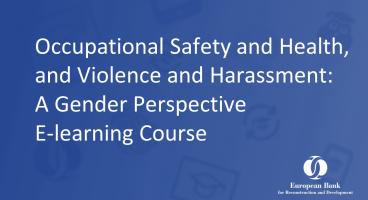About the Course
Welcome to the "Occupational Safety and Health, and Violence and Harassment: A Gender Perspective" E-learning Course.
This e-course has been created in collaboration between the European Bank for Reconstruction and Development (EBRD) and the World Bank.
The course looks at Occupational Safety, Occupational Health, and Violence and Harassment in the workplace from the perspective of gender and examines differential risks for women or men that may be present. It is beneficial for a broad range of audiences, including workplace managers, workers, industries, especially those where OSH hazards are particularly pronounced (e.g., transport, construction, energy), governments, and technical universities.
As the title suggests, there are three main elements to this course: Occupational Safety, Occupational Health, and Violence and Harassment in the workplace. The course has been commissioned explicitly to look at these three areas from the perspective of gender and any differential risks for women or men that may be present. Currently, there is no easily digestible training course on this topic out there, only bulky documents, and this training course fills in this important information and training gap.
This course has been designed and written to meet the needs of the following populations:
- Workplace managers, especially those responsible for recruitment and/or workplace Occupational Safety and Health issues;
- Workers and their representatives;
- Trade Unions;
- Civil Society Organizations including women’s rights groups;
- Industries, especially those where health and safety hazards are some of the most pronounced (transport, construction, energy, mining, etc.);
- Governments and their enforcing agencies, and vi) Technical universities.
Course Curriculum
The following are the main learning objectives for this course:
LO1: To provide an understanding of the breadth of these three subject areas (Occupational Safety, Occupational Health, and Violence and Harassment in the workplace).
LO2: To provide an understanding of cases in which these three hazard areas are found, and in such cases how to:
o determine the scale of the potential problem;
o assess the potential problem;
o eliminate or control the potential problem; and ultimately,
o determine the various ways this problem impacts upon gender.
Before the course delves into each of these three topic-specific modules, it starts with an overview module on the fundamentals of Occupational Safety and Health and Violence and Harassment and explains how they are interrelated, particularly from a woman’s perspective.
The Occupational Health module takes learners through the various hazard groupings and explores some examples; takes a considered look at the resultant health effects; reviews how exposure to hazards might be measured; and then concentrates on how these exposures might be mitigated and controlled to prevent disease happening or to stop its progression. Whenever and wherever possible, all of these steps are considered within a gender perspective, recognizing that the impact of hazards in the workplace can affect women and men differently.
The Occupational Safety module starts off by exploring the fundamental human right of being able to go to work and not be injured there; this is reinforced by describing the necessity for employers to prevent rather than simply control hazards in the workplace. The concept of safety within the context of gender is explored and expanded by describing the importance of considering diversity (gender, age, etc.) in creating individual differences in the perception of safety risks. To reinforce potential gender differentials a number of areas of safety are used as examples (use of tools and equipment, manual handling, etc.). The use of personal protective equipment (PPE) is also explored in some detail because of its common use and misuse, as well as a frequently seen gender bias having to do with the shape, size, etc. of the equipment. Lastly, the often-repeated mantra of Plan, Do, Check, and Act is explained within the context of safety – and shows that this basic approach has much in common with the two other modules.
The third module deals with Violence and Harassment in the Workplace. With the shifting of work away from the historic manufacturing, heavy engineering, and extractive industries, classic exposures to hazards and the diseases they cause have waned, only to reveal and, or be replaced by an equally damaging though perhaps less obvious and more insidious workplace hazard – that of violence and harassment. This module will examine the prevalence of physical, psychological, and sexual violence and harassment, taking into account gender perspectives. Significant emphasis has been given to the various policies, processes, and procedures that can be used to facilitate the identification, assessment, and elimination of the problem.
Each of these three modules finishes with a short quiz to test the participants’ knowledge.
Acknowledgments:
The course has been developed with the support of the Azerbaijan Technical Assistance Facility (AZTAF), which is a technical assistance program for the Republic of Azerbaijan financed by the European Union and implemented by the World Bank, and the EBRD Shareholder Special Fund (SSF).
The course was designed and led by Nato Kurshitashvili (Senior Gender Specialist, World Bank) and Derran Williams (Senior Health and Safety Advisor, EBRD) with the authorship of selected chapters by Professor Kerry Gardiner (Introductory modules and Occupational Health), Lamis Al Kaisi (Occupational Safety) and Shams Mustafayeva (Violence and Harassment in the World of Work). The team would like to thank John V Tran (Senior Environmental Specialist, World Bank) and Duncan Spencer (Head of Advice and Practice, The Institution of Occupational Safety and Health) for their detailed comments that improved the training course. The team acknowledges Vusala Asadova (World Bank) and Victoria Protsenko (EBRD) for their coordination support. The team is grateful to Janet Hulstrand for editing the report, to Bidya Sapam for preparing the PowerPoint material, and to Dmitry Sambuk for the final formatting of the training materials.
Supported by:


